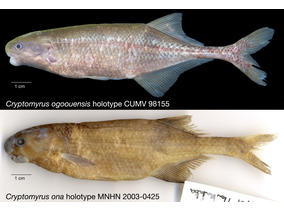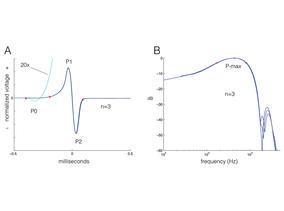Vous êtes ici
Mormyridae
Cryptomyrus ogoouensis Sullivan, Lavoué & Hopkins, 2016
Nomenclature
-
Subfamily: MormyrinaeGenus: Cryptomyrus
SUMMARY
Diagnosis
Cryptomyrus ogoouensis sp. n. is readily differentiated from its sole congener, C. ona sp. n., in the possession of an anal-fin origin located well in advance of the dorsal fin (first dorsal ray above anal-fin ray 7 vs. first dorsal ray above anal-fin ray 3), a narrow caudal peduncle (depth 5.1% SL vs. 6.0–6.8% SL), and lobes of caudal fin nearly as long as caudal peduncle (vs. markedly shorter).
Description
Morphometric and meristic data for holotype (female, 111.6 mm SL) presented in Table 4. Maximum size of this species unknown. Body fusiform with dorsal and ventral profiles gently convex, greatest body depth between terminus of pelvic fin and urogenital pore. Body compressed, widest at head. Dorsal head profile very nearly straight from back of head to above eye, a slight indentation above anterior margin of eye and abruptly angled at tip of snout. In lateral view, upper lip to tip of snout nearly a straight line, forming a 90° angle with top of head. Ventral profile of head with marked concavity between gular region and chin, body depth increasing rapidly from there to below mid level of pectoral fin. Snout blunt, deep and broad, rounded from above. Tip of snout on level with center of eye, projecting beyond upper lip. Nostrils well separated from each other and from eye; posterior naris at level of bottom of orbit, anterior naris just below line through center of eye; straight line drawn through nostrils passes through tip of snout and just below pectoral-fin origin. Mouth subinferior, small, rictus beneath posterior naris in advance of eye. Chin swelling present: expansive, but not protruding beyond snout. Premaxillary teeth 5, notched, dentary teeth 6, broad, squarish, spatulate, center four oriented horizontally. Center two projecting beyond neighboring pair, longest along inner edges (Fig. 6). Eye large, laterally positioned on head. Predorsal distance greater than preanal distance; anal-fin origin well in advance of dorsal fin: first dorsal ray above anal-fin ray 7 (branched ray 4); dorsal-fin base shorter than anal-fin base; dorsal-fin rays 3+21, anal-fin rays 3+28; 3 anal-fin rays beyond last dorsal-fin ray. Dorsal fin with strongly falcate posterior margin. Longest dorsal-fin ray is second branched ray; next 10 rays successively shorter; final 8 rays equal in length. Anal fin with gently falcate posterior margin. Longest anal-fin ray is third branched ray; next 13 rays successively shorter, final 12 rays equal in length. Pectoral fin long and pointed distally, with 10 rays, extending to vertical through middle of pelvic fin. Pelvic fin with 6 rays, closer to pectoral-fin origin than to anal-fin origin. Caudal peduncle narrow, depth at middle equal to depth at origin. Caudal fin deeply forked with 20 rays in each lobe, lobes long with rounded ends, scaled at bases; distance from caudal flexion to caudal tips roughly equal to CPL. Body covered by thin, cycloid scales, head naked. Body scales large along sides, smaller dorsally: 43 pierced lateral line scales + 2 unpierced along midlateral line, 19 scales in transverse series between origins of dorsal and anal fins, 9 from pelvic fin to midlateral line, 12 around caudal peduncle. Total vertebrae 43; epineurals associated with vertebrae 1–9, vertebral centra 2–13 with pleural ribs directly attached, vertebrae 14–17 with pleural ribs displaced beneath haemal arches; caudal vertebrae 18–43. Hypurals 1 & 2 unfused.




